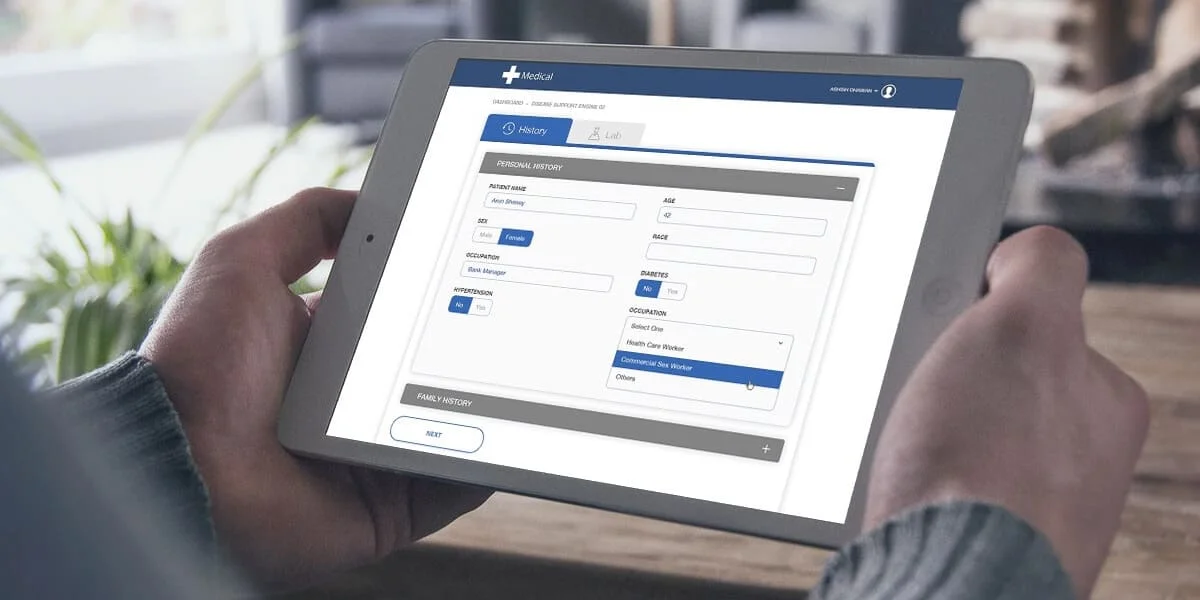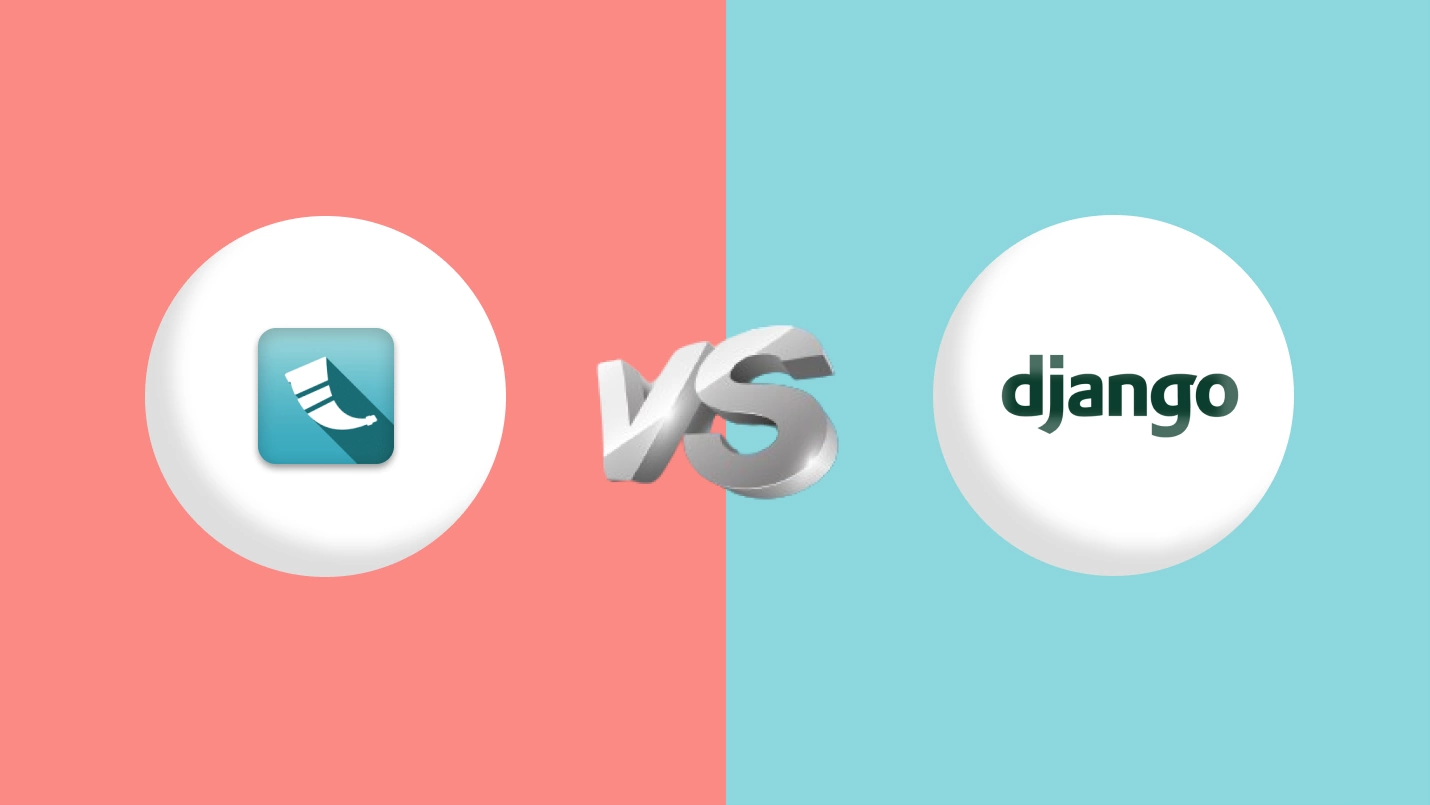Ask any Python developer — newcomers or skilled ones— they’ll agree on its reliability and efficient speed. According to the Popularity of Programming Language Index, they grew the most over the last five years by 8.7%. The TIOBE index puts Python web application development in 1st place among the most used languages in the world.
However, Python does not accompany the built-in features required to accelerate custom web application development. Hence, many developers choose Python’s robust collection of frameworks to deal with the subtleties of execution. Developers can work with and deploy these Python frameworks for web development.
This blog discusses the top Python frameworks that a web development company should choose in 2025.
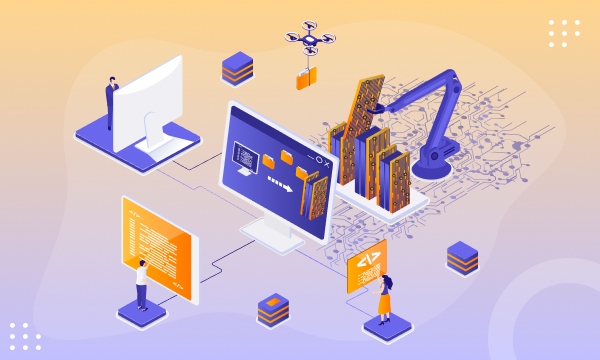
We respect your privacy. Your information is safe.
Popular Python frameworks 2025
1. Django
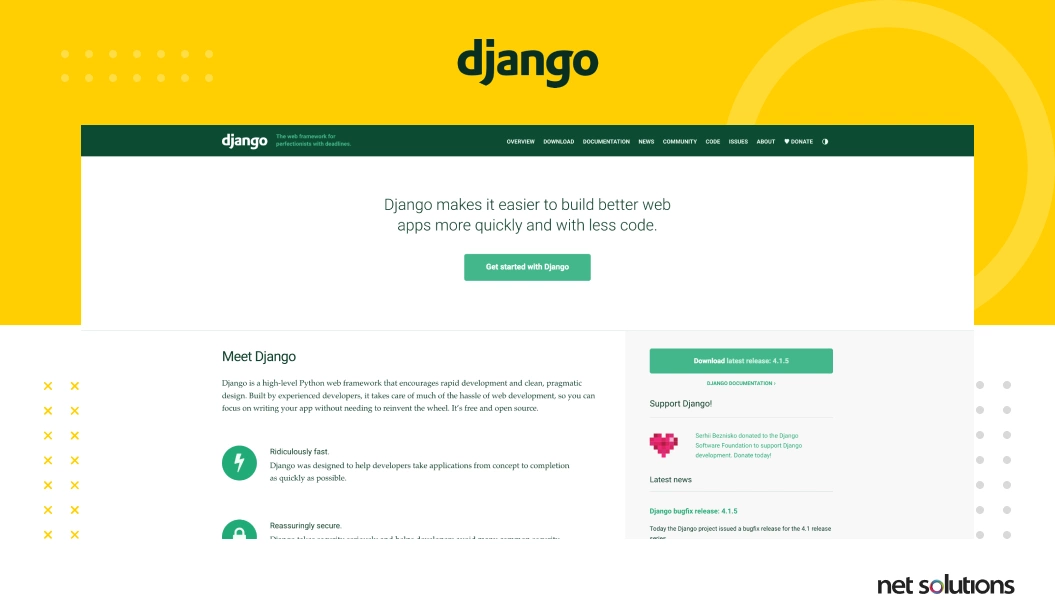
Django is a free, open-source Python framework that enables developers to develop complex code and apps quickly. Python web developers can build quality web applications using it.
Django is among the best python frameworks and is quickly used to develop APIs and web applications. Over 12,000 known projects have been developed in it. The Python framework is popular because of its vast collection of libraries, less need for coding, and the reusability of components.
Key Features of Django
- Assists you in defining patterns for the URLs in your app.
- Built-in authentication system.
- Simple yet powerful URL system.
- Object-oriented programming language database that offers the best data storage and recovery.
- The automatic admin interface feature enables editing, adding, and deleting things with customization.
- A caching framework accompanies multiple cache mechanisms.
2. CherryPy
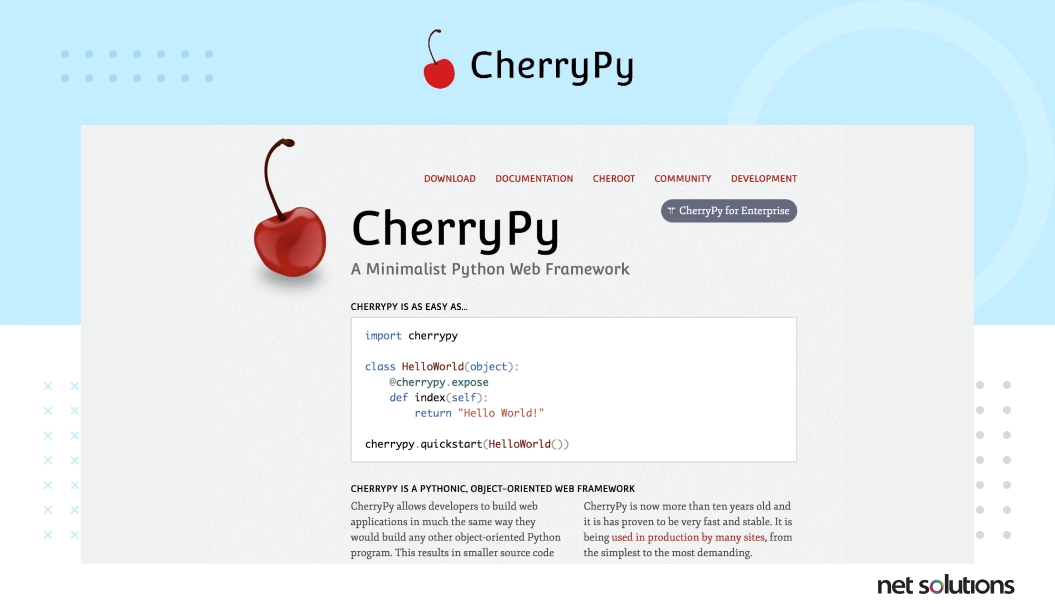
CherryPy is a rapid, stable, and minimalistic Python web development framework. It is open-source and can run on any working framework that supports Python.
The CherryPy web framework empowers you to use any technology for data access and templating. It can do everything a web framework can, such as sessions, file uploads, static, cookies, etc.
CherryPy also allows developers to develop web apps as they would develop any other object-oriented Python program. This results in the development of minor source code in less time.
Key Features of CherryPy
- A consistent, HTTP/1.1-compliant, WSGI thread-pooled webserver
- Easy to run various HTTP servers (for example, on multiple ports) at once
- Runs on Python 2.7+, 3.5+, PyPy, Jython, and Android
- Built-in tools for encoding, sessions, caching, authentication, static content, and many more
- A powerful configuration system for developers and deployers alike
- Built-in profiling, coverage, and testing support
3. Pyramid
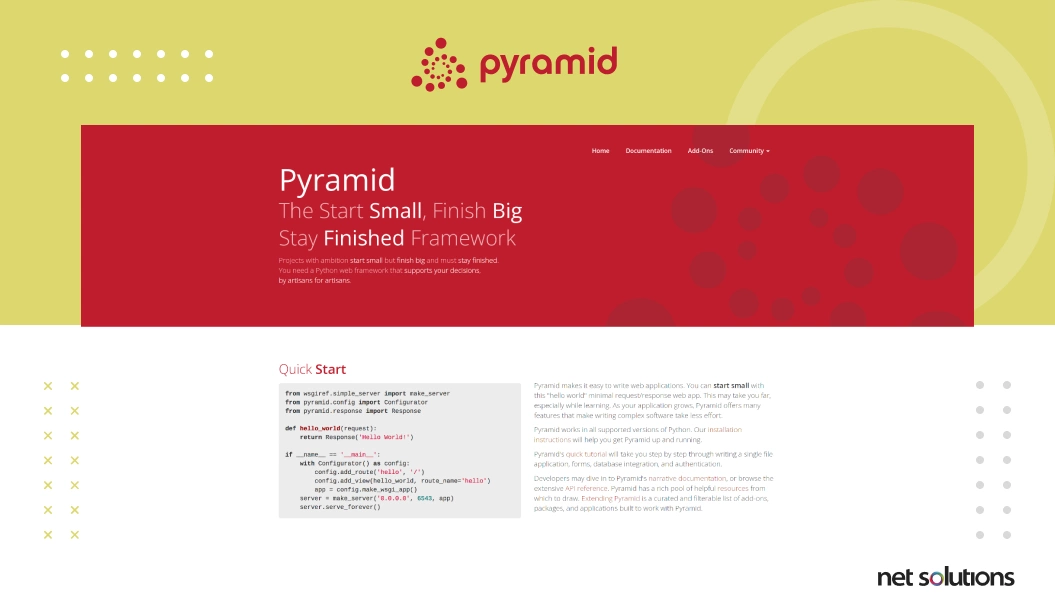
Tech giants like Mozilla, Yelp, Dropbox, and SurveyMonkey use the Pyramid Python web development framework. The framework is popular because of its flexible and minimalist nature. Pyramid runs on Python 3.
Developers can use the Pyramid framework to develop essential web apps and complex projects. Even experienced Python developers keep it in high regard because of transparency and measured quality.
Key Features of Pyramid
- Ability to run well with both small and large apps
- URL mapping based on Routes configuration through URL dispatch and WebHelpers
- HTML structure validation and generation
- All-embracing templating and asset details
- Testing, support, and comprehensive data documentation
- Flexible authentication and approval
4. Grok
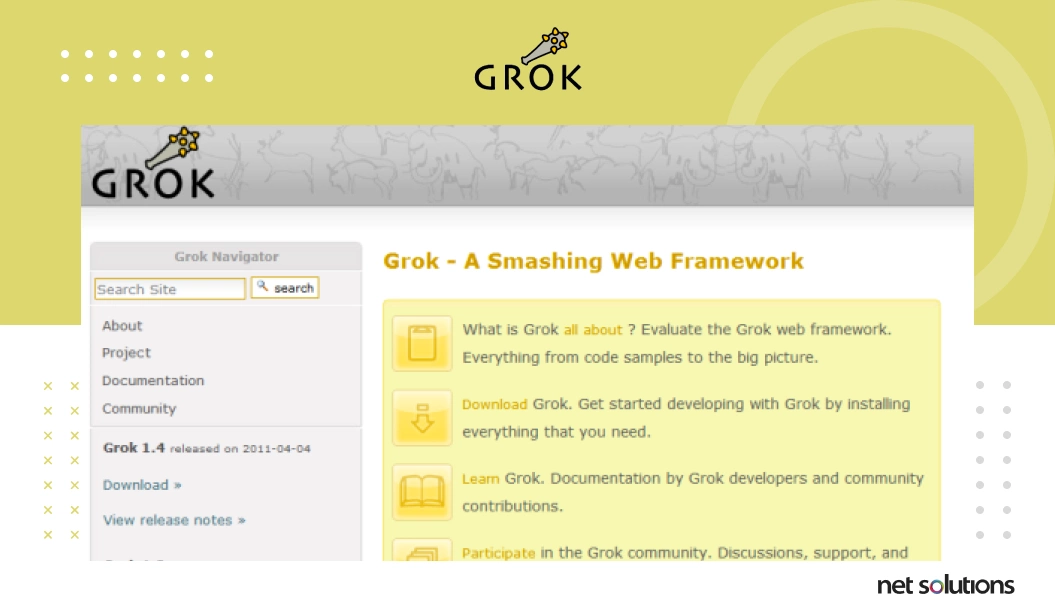
Grok is a web framework based on the Zope toolkit (ZPK) technology. It gives an agile development experience to developers by concentrating on two general principles:
- Convention over configuration
- DRY (Don’t Repeat Yourself)
The Grok framework is open-source and aims to speed up app development.
Developers can choose from a broad scope of network and independent libraries as indicated by the task needs in Grok. Also, the framework’s UI (user interface) is like other full-stack Python frameworks like Pylons and TurboGears.
Key Features of Grok
- Offers a strong foundation for developing robust and extensible web applications
- Enables web developers to take advantage of the power of Zope 3
- A robust object database for storage
- Integrated data security to ensure your application and grant access to specific users
- Grok component architecture helps developers lessen the unpredictability of development
- Offers the building blocks and other essential assets to develop custom web applications for business needs
5. TurboGears
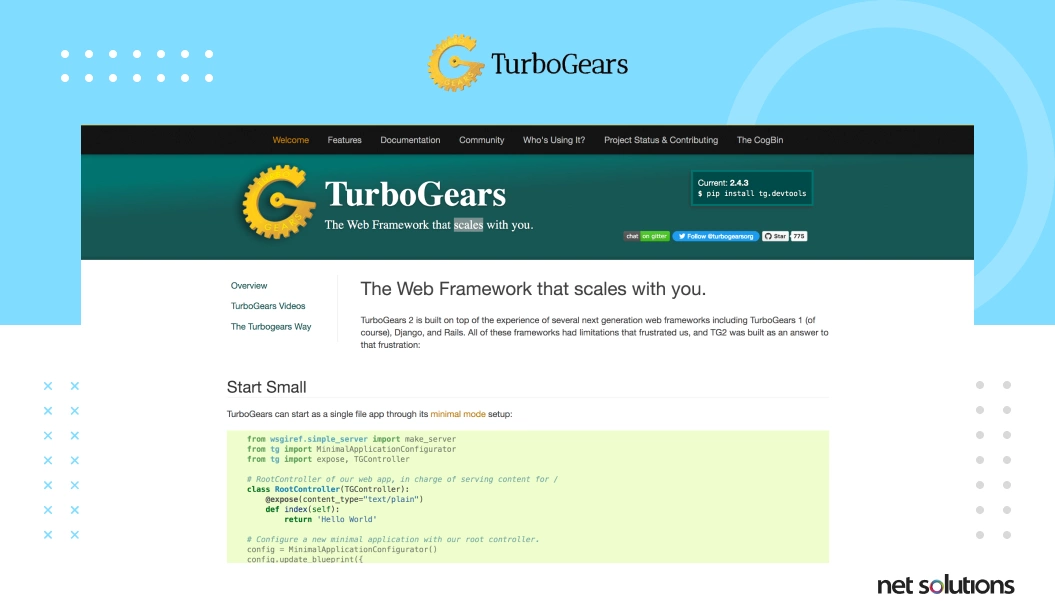
TurboGears is a data-driven full-stack web application Python framework. It is designed to overcome the inadequacies of various extensively used web and mobile app development frameworks. It empowers software engineers to begin developing web applications with an insignificant setup.
TurboGears allows web developers or Python web development companies to streamline Python website development utilizing various JavaScript development tools. You can develop web applications using elements like SQLAlchemy, Repoze, WebOb, and Genshi much faster than existing frameworks. It supports different databases and web servers like Pylons.
The framework pursues an MVC (Model-View-Controller) design. Also, it incorporates vigorous formats, an incredible Object Relational Mapper (ORM), and Ajax for the server and program. Organizations using TurboGears include Bisque, ShowMeDo, and SourceForge.
Key Features of TurboGears
- All features are executed as function decorators.
- Multi-database support.
- Accessible command-line tools.
- MochiKit JavaScript library integration.
- MVC-style architecture and PasteScript templates.
- ToscaWidgets to ease the coordination of frontend design and server deployment.
6. Web2Py
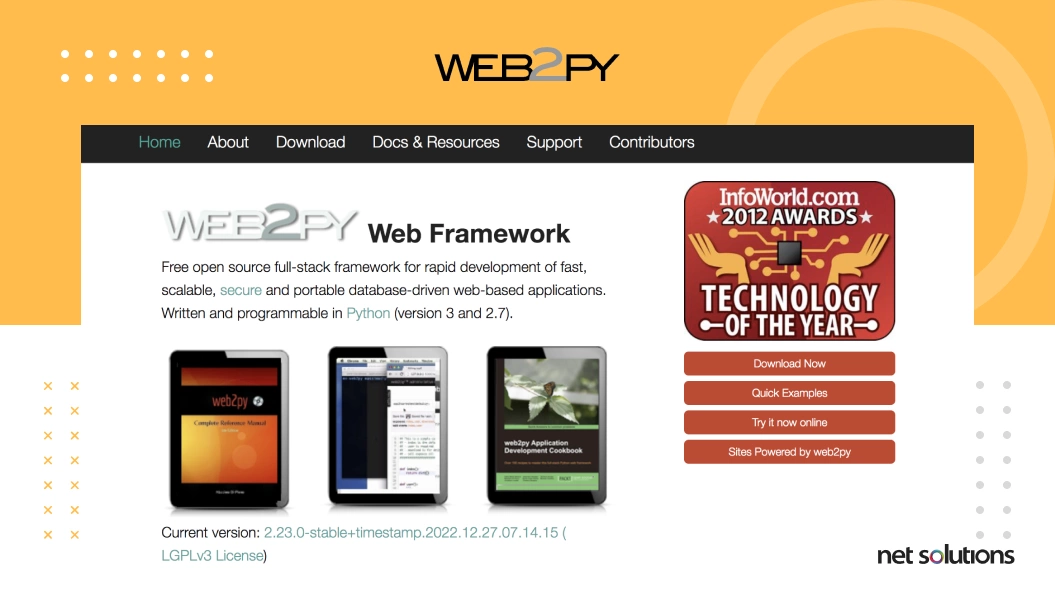
Web2py accompanies a debugger, code editor, and deployment tool to test and keep up with web applications. It’s a cross-platform framework that underpins Windows, Unix/Linux, Mac, Google App Engine, and other platforms.
The framework streamlines Python app development procedure via a web server, SQL database, and an online interface. It enables clients to build, revise, deploy, and manage web applications via web browsers.
The key component of Web2py is a ticketing framework, which issues a ticket when a mistake occurs. This encourages the client to follow the mistake and its status. Also, it has in-built components to manage HTTP requests, reactions, sessions, and cookies.
Key Features of Web2py
- Supports settlement over configuration and facilitates rapid web development.
- Supports MVC Architecture to simplify web development.
- Enables developers to work with broadly used relational and NoSQL databases.
- Web-Based IDE to accelerate web development projects like cleaning temp files, editing app files, running tests, and browsing past tickets.
- It comes with Useful Batteries to build various web apps efficiently without using external tools and services.
- Keeps the web apps secure by addressing top vulnerabilities and security issues.
7. Flask
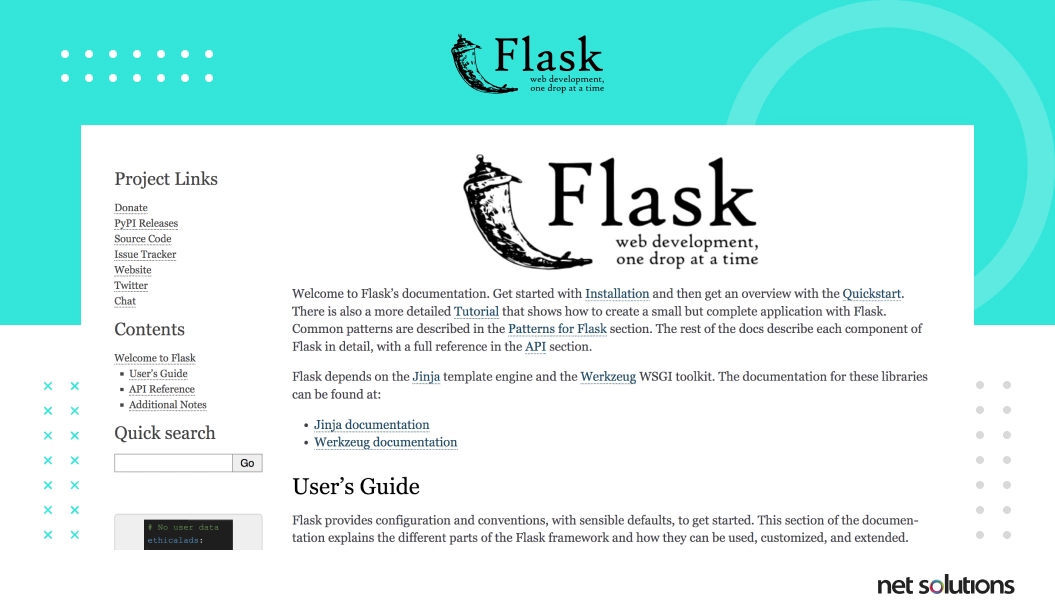
Flask is a Python framework accessible under the BSD license inspired by the Sinatra Ruby framework. Flask relies upon the Werkzeug WSGI toolbox and Jinja2 template. The primary purpose is to help develop a robust web application base.
Developers can develop the Python backend framework any way they need. However, it was designed for open-ended applications. Flask has been used by big companies, which include LinkedIn and Pinterest.
Compared to Django, Flask is best suited for small and easy projects. Thus, you can expect web server development, support for Google App Engine, and in-built unit testing.
Key Features of Flask
- Built-in development server and debugger.
- RESTful request dispatching.
- Integrated unit testing support (code with quality).
- Uses Jinja2 templating (tags, filters, macros, and more).
- 100% WSGI 1.0 compliant.
- The community provides multiple extensions that ease the integration of new functionalities.
8. Bottle
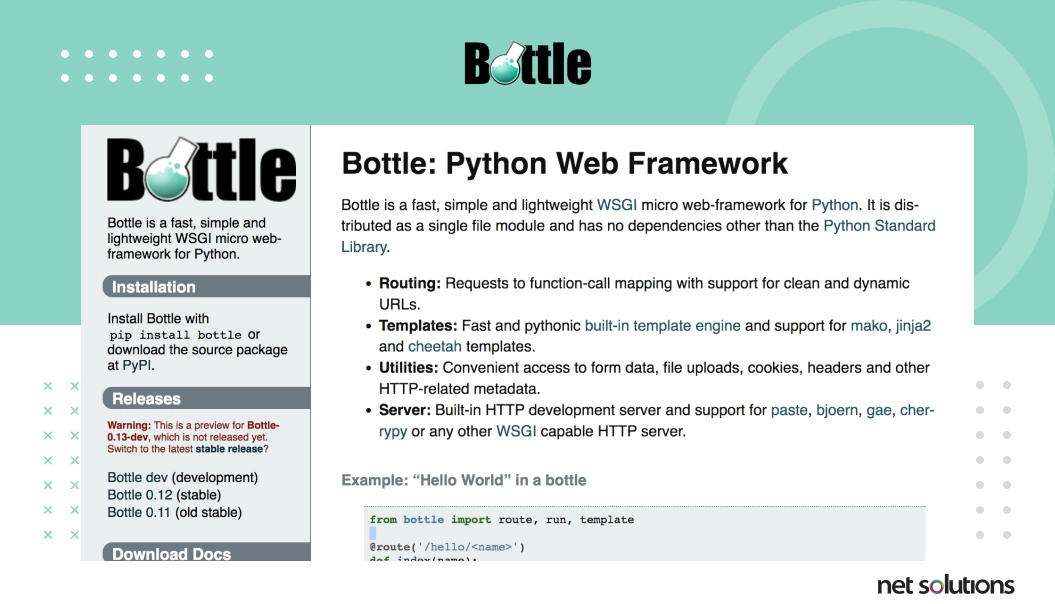
The bottle is one of the best Python web frameworks, which falls under small-scale frameworks. Initially, it was developed for building web APIs. Also, Bottle tries to execute everything in a single source document. It has no other dependencies than Python Standard Library.
The out-of-the-box functionalities of Bottle include templating, utilities, directing, and fundamental abstractions over the WSGI standard. Like Flask, you will be coding significantly closer to the metal than with a full-stack framework.
Bottle enables developers to work closer to the hardware. It not only builds simplistic personal-use apps but is an apt place for learning Python frameworks and prototyping. For example, Bottle has been used by Netflix for its web interfaces.
Key Features of Bottle
- Spotless and dynamic URL routes for mapping by using simplified syntax.
- Quick and pythonic built-in template engine and backing.
- WSGI framework works with CGI, and WSGI internals is accessible.
- Permits easy access to data, cookies, file uploads, and other HTTP-related metadata.
- Worked in HTTP server and backing for glue, fapws3, flup, or some other WSGI-competent HTTP server.
- Speed optimizations for testing and high performance.
9. Tornado
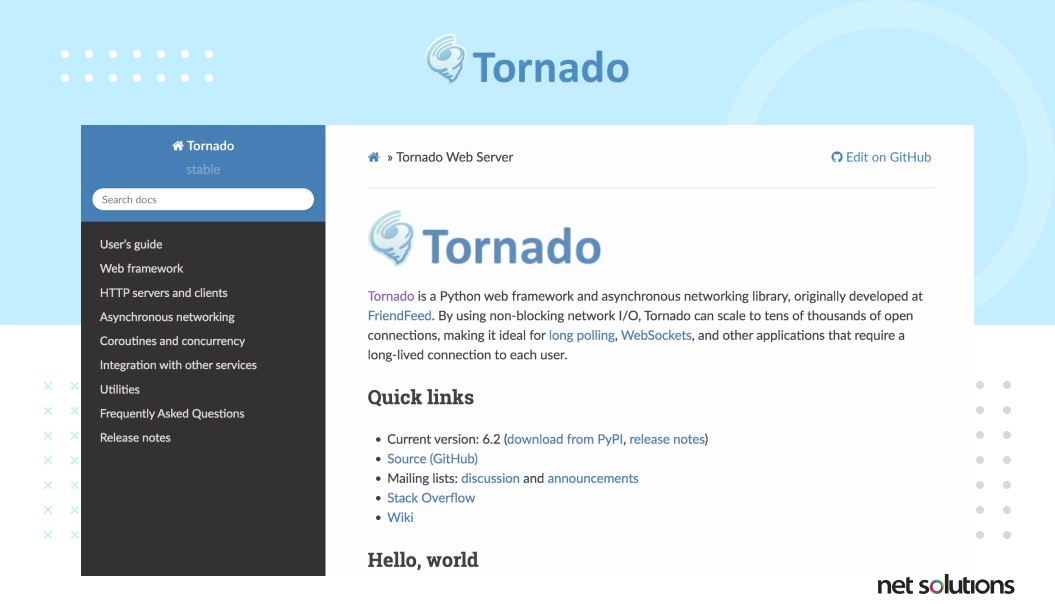
Tornado is a Python web framework and offbeat framework library. It utilizes a non-blocking framework I/O. Also, the framework unravels the C10k issue (which means that, whenever configured correctly, it can deal with 10,000+ simultaneous connections).
This makes it an extraordinary tool for building applications that require superior and a vast number of simultaneous clients.
Key Features of Tornado
- Allows implementation of 3rd-party authentication and authorization schemes.
- Superior quality, real-time services, and non-blocking HTTP customers.
- It offers high-quality output.
- Support for interpretation and localization.
- User authentication support and Web templates.
10. BlueBream
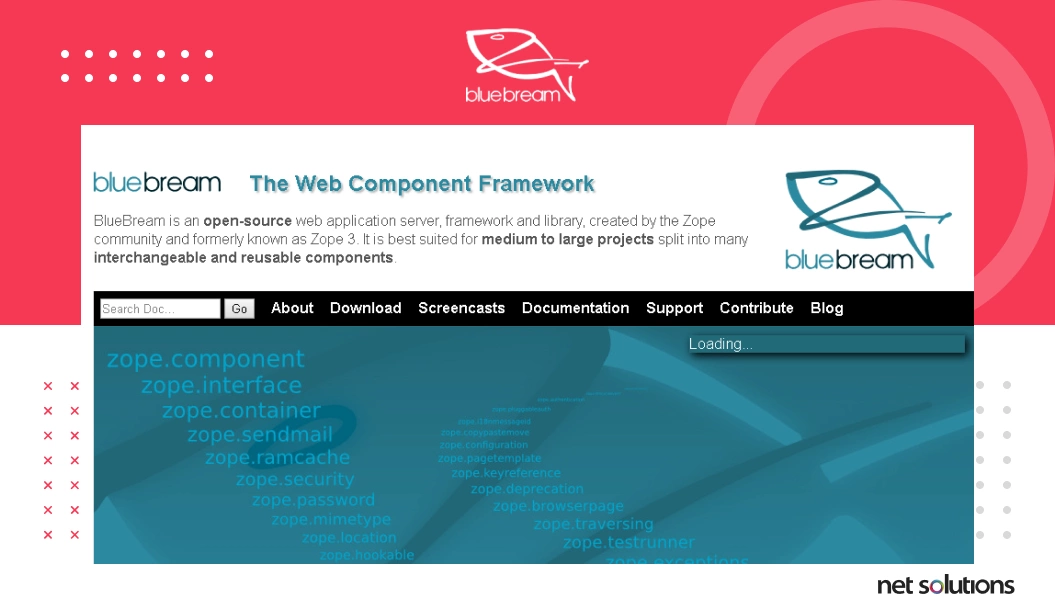
BlueBream is also an open-source web application framework, server, and library for website developers. It was developed by the Zope team and was formerly known as Zope 3. This framework best suits medium and substantial activities apportioned into various re-usable and well-suited segments.
BlueBream relies upon Zoop Toolkit (ZTK). It holds extensive periods of experience, ensuring that it meets the main essentials for enduring, relentless, and adaptable programming.
Key Features of BlueBream
- Emphasizing Python Web Server Gateway Interface (WSGI) compatibility.
- Unit and functional testing frameworks.
- The primary mechanism for plugged security approaches.
- An XHTML-compliant language for developing templates.
- A tool for automatically generating forms.
- The Zope Component Architecture (ZCA) executes the separation of concerns to develop strong reusable components.
11. Quixote
Quixote framework is for writing Web-based applications with Python. Its objectives are adaptability and better performance in a specific order.
Quixote applications are developed in the traditional technology. Thus, if a Python developer is keen to try or learn the ‘real programming language,’ then Quixote is for them. The logic for formatting web pages comprises Python classes and functions.
There are three significant versions of Quixote. Versions 1 and 2 resemble each other but are different. Version 1 is no longer maintained effectively. But version 3 needs Python 3, like Quixote 2. Many public websites use versions 2 and 3.
Key Features of Quixote
- Simple and flexible design with session management API.
- Library of functions to assist in developing and analyzing an HTML form.
- HTML templates are written in Python-like syntax and can be imported like another Python code.
- Works with any web server that supports CGI or Fast CGI
- Supports Apache’s mod_python
- SCGI protocol is also supported
Frequently Asked Questions
There are two types of Python frameworks – Full Stack Framework and Non-Full Stack Framework. The full-stack Python frameworks give full support to developers, including essential components like form generators, form validation, and template layouts.
Bottle is a Python framework that’s easiest to start for beginners. It is because Bottle implements everything in a single source file and has no dependencies besides the Python standard library.
Django is a full-stack development Python web development framework that follows a battery-included philosophy. Django has all the functionalities you need to build a fully-fledged web application.
Here’s why you should learn Python for web development:
- Python because it is easy to use and can handle a lot of data.
- There’s a Python library for everything.
- Python has a large community to support you in good and bad times.


